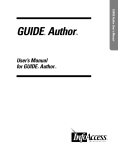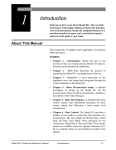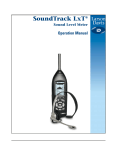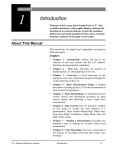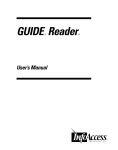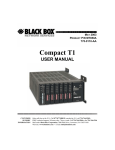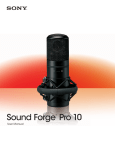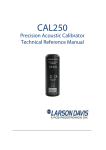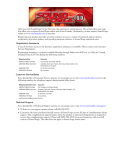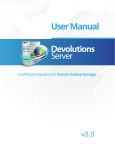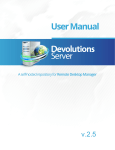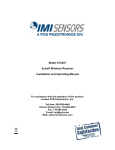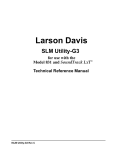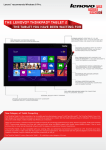Download I021.01 (A) NoiseTutor System Manual
Transcript
NoiseTutor System Manual Larson Davis NoiseTutor System Manual I021.02 Rev A NoiseTutor System Manual Copyright Copyright 2011 by PCB Piezotronics, Inc. This manual is copyrighted, with all rights reserved. The manual may not be copied in whole or in part for any use without prior written consent of PCB Piezotronics, Inc. Disclaimer The following paragraph does not apply in any state or country where such statements are not agreeable with local law: Even though PCB Piezotronics, Inc. has reviewed its documentation, PCB Piezotronics, Inc. makes no warranty or representation, either expressed or implied, with respect to this instrument and documentation, its quality, performance, merchantability, or fitness for a particular purpose. This documentation is subject to change without notice, and should not be construed as a commitment or representation by PCB Piezotronics, Inc. This publication may contain inaccuracies or typographical errors. PCB Piezotronics, Inc. will periodically update the material for inclusion in new editions. Changes and improvements to the information described in this manual may be made at any time. Record of Purchase Date and Serial Number Model 831 or SoundTrack LxT: ________ Serial Number: ___________ Preamplifier Model: _________ Serial Number: ___________ Microphone Model: _________ Serial Number: ___________ Recycling PCB Piezotronics, Inc. is an environmentally friendly organization and encourages our customers to be environmentally conscious. When this product reaches its end of life, please recycle the product through a local recycling center or return the product to: PCB Piezotronics, Inc. Attn: Recycling Coordinator 1681 West 820 North Provo, Utah, USA 84601-1341 where it will be accepted for disposal Product Warranty Refer to our website, www.larsondavis.com, for a copy of the product warranty. Table of Contents Chapter 1 Introduction 1-1 Setting up the NoiseTutor Station ................................................... 1-2 Configuring the NoiseTutor Server ................................................. 1-3 System requirements for NoiseTutor Server Configuration ........... 1-4 Installing NoiseTutor System Software .......................................... 1-4 System Requirements for NoiseTutor System Software .................1-4 Chapter 2 Setting up the NoiseTutor Server 2-1 Installing IIS on Windows 7 ........................................................... 2-1 Installing the NoiseTutor Server Configuration Tool ................... 2-11 Running the NoiseTutor Configuration Tool ................................ 2-13 Creating User Accounts for FTP Uploads .................................... 2-17 Setting up FTP Servers .................................................................. 2-27 Configuring Windows Firewalls ................................................... 2-31 Verifying Access to FTP Servers .................................................. 2-40 Local Access ....................................................................................... 2-40 Local Network Access ........................................................................2-41 Public Access ...................................................................................... 2-42 Verifying Browser Connections .................................................... 2-43 Chapter 3 Installation and Set-up 3-1 Installing NoiseTutor Software ....................................................... 3-1 Starting the NoiseTutor Station ....................................................... 3-3 Installing NoiseTutor System Licenses ........................................... 3-4 Setting up Data Transmission ......................................................... 3-5 Deliver Data Files via E-mail ................................................................ 3-5 Deliver Data Files to an FTP Site ....................................................... 3-10 Create and Deliver Graphical Reports via E-mail ............................... 3-12 Create and Publish Graphical Reports to Web Site ............................ 3-15 Chapter 4 NoiseTutor Station Setup Menu 4-1 Working Mode ...................................................................................... 4-2 I021.02 Rev A NoiseTutor System Manual Main Setup ............................................................................................ 4-3 Recipient Lists ...................................................................................... 4-5 Graph Setup .......................................................................................... 4-7 Data File ............................................................................................... 4-9 E-mail Service ..............................................................................................4-9 FTP Setup Service ......................................................................................4-11 Realtime Report Setup ........................................................................ 4-12 E-mail Publishing .......................................................................................4-13 Web Publishing ..........................................................................................4-14 System Administration Messages ....................................................... 4-18 Chapter 5 Commands Menu 1 Main commands ................................................................................... 5-1 Appendix A Technical Specifications A-1 System Power Requirements ................................................................A-1 Physical .................................................................................................A-1 Environmental ......................................................................................A-1 Station PC (provided) ...........................................................................A-2 Items not Included ................................................................................A-2 Appendix B Shipping Instructions B-1 CHAPTER 1 Introduction This manual describes how to set up and configure the Larson Davis NoiseTutor System. The NoiseTutor System is designed to interact with noise monitoring stations. It provides portable and remote observation of monitoring sites through a web interface. Setting up the NoiseTutor System includes the following steps: The NoiseTutor System software comes pre-installed when NoiseTutor is purchased as a system. NoiseTutor System Manual Step 1 Setting up the NoiseTutor station Step 2 Configuring the NoiseTutor server Step 3 Installing the NoiseTutor System software, if not already pre-installed. Figure 1-1 shows the components and architecture of the NoiseTutor System. Introduction 1-1 FIGURE 1-1 Components and Architecture - NoiseTutor System Setting up the NoiseTutor Station Start by reading the NoiseTutor Quick Start Guide. It is a card located inside your station case that describes the steps for deploying your NoiseTutor station. To set up your NoiseTutor station, refer to the NoiseTutor Quick Start Guide and the NoiseTutor Installation Reference. • The NoiseTutor Quick Reference Guide The NoiseTutor Installation Reference is located inside your NoiseTutor station case and describes the assembly and operation of your station. • The NoiseTutor Installation Reference • Model 831 or SoundTrack LxT® sound level meter • Preamplifier model PRM831, PRMLxT1, PRMLxT1L, PRMLxT2, or PRMLxT2L. • Microphone model number 377B02 or 377B20 • Microphone cable connecting preamplifier/microphone NoiseTutor System Manual The NoiseTutor station consists of the following: Model 831 to 1-2 Note: Larson Davis does not supply an active SIM card. You must obtain one separately. • Active SIM card Refer to the NoiseTutor Installation Reference on the inside of the NoiseTutor case to install your system hardware. Configuring the NoiseTutor Server Larson Davis provides server configuration aids with the NoiseTutor System to provide web access to sound level monitoring sites. This includes the NoiseTutor Server Configuration Tool that can be used with the instructions in this manual to set up a server on a Windows-based computer. The server consists of both a website--with a collection of pre-designed web pages--and an FTP site. The pre-designed server web pages present information from each monitoring site in the following forms: • Ten-minute report • One-hour report • One-day report • One-week report • One-month report Although you can use any web site server that is capable of rendering HTML pages, along with Java Script, with the NoiseTutor System, the configuration aids in this manual describe the steps for using Internet Information Services (IIS) from Microsoft. This manual describes configuration with IIS because it is currently the most common web server for Windows and it is available at no cost. Although the NoiseTutor system provides server configuration aids, you are responsible for setting up the web server. By setting up an FTP site, you can collect noise monitoring data from Noise Tutor clients. This data can then be displayed in graphic reports for each monitoring site on a web site. The process of installing and configuring the NoiseTutor Server involves complex and technical tasks, and generally requires the services of an IT professional. For your assistance, detailed instructions for installing and configuring the NoiseTutor Server on a Windows 7 platform are provided in this manual. The NoiseTutor System also functions on Windows XP SP 3 and Windows Vista SP 1. However, the steps and options are 1-3 NoiseTutor System Manual different than those represented in this manual. To install and configure the NoiseTutor System on these platforms, Larson Davis recommends that you consult with an IT professional. Detailed instructions for setting up a server on other platforms are not available from Larson Davis. System requirements for NoiseTutor Server Configuration • Windows 7 SP 1, Server or Professional editions. Server edition is recommended. • IIS 5.1 or higher • One or more NoiseTutor Noise Monitoring Systems (NMS) • One 831 analyzer serial number for each NMS Installing NoiseTutor System Software The NoiseTutor System software comes pre-installed when ordering the NMS-021 (with Model 831 or SoundTrack LxT analyzers), and the EPS 041 (without Model 831 or SoundTrack LxT analyzers). For other configurations, the software must be installed on the PC that is connected to the sound level meter. The software interacts with noise monitoring stations by downloading measured data from the sound level meters at predefined intervals. It then sends data or graphical reports to specified recipients. If your system does not include pre-installed software, refer to the instructions in the chapter “Installation and Setup.” System Requirements for NoiseTutor System Software NoiseTutor System Manual • Larson Davis analyzers 824, 831 and SoundTrack LxT. • All Windows operating system versions, starting from Windows 2000. 1-4 CHAPTER 2 Setting up the NoiseTutor Server This chapter lists and describes the steps for setting up the NoiseTutor server on the Windows 7 operating system. To install the server, complete the following process: Although the NoiseTutor System provides server configuration aids, you are responsible for setting up the web server. 1. 2. 3. 4. 5. 6. Install IIS on Windows 7. Configure the IIS web server. Install the NoiseTutor Server Configuration Tool. Run the NoiseTutor Server Configuration Tool. Create an FTP user account. Configure the Windows Firewall. Each step is described in more detail in the following sections. Before You Begin: The process of installing and configuring the NoiseTutor Server involves complex and technical tasks, and generally requires the services of an IT professional. These detailed instructions are provided for the convenience of an IT professional working with your NoiseTutor System. Installing IIS on Windows 7 The NoiseTutor System also functions on Windows XP SP 3 and Windows Vista SP 1. However, the steps and options are different than those represented in this manual. To install and configure the NoiseTutor System on these platforms, Larson Davis recommends that you consult with an IT professional. Detailed instructions for setting up a server on other platforms are not available from Larson Davis. Installing the IIS addin provides your host PC with both web- and FTP-server functionality. If you do not want to use IIS, you will need to supply your own web server and FTP server. To install IIS, follow these steps: NoiseTutor System Manual Setting up the NoiseTutor Server 2-1 If the Programs and Features icon is not displayed in your Control Panel, click the drop down arrow in the address bar following the words “Control Panel.” Click All Control Panel Items. The Programs and Features icon should then appear with other icons in your Control Panel. Step 1 On the Start menu, click Control Panel. Step 2 Click Programs and Features. Step 3 On the left window border, click Turn Windows features on or off, as shown in FIGURE 2-1. FIGURE 2-1 Turn Windows Features On or Off Step 4 Select Internet Information Services. Step 5 Expand Internet Information Services. Step 6 Expand FTP Server. Select all items, as shown in FIGURE 2-2. NoiseTutor System Manual 2-2 Step 7 Select Web Management Tools, as shown in FIGURE 2-2. Accept all defaults. Step 8 Select World Wide Web Services, as shown in FIGURE 2-2. Accept all defaults. FIGURE 2-2 Windows Features - Internet Information Services Step 9 Click OK.Wait for Windows to make changes, as shown in FIGURE 2-3. FIGURE 2-3 Microsoft Windows - Please Wait 2-3 NoiseTutor System Manual Step 10 Close Programs and Features. Configuring the IIS Web Server You can configure the IIS web server to set up your NoiseTutor web site. The following configuration places the web pages for your site in a virtual directory and sets the FTP server upload location as a subdirectory of that virtual directory. To set up your web site, follow these steps: Step 1 Browse to c:\inetpub\wwwroot\. Click the New Folder button and name it LarsonDavis. Step 2 Open inetmgr at the following location: c:\windows\system32\inetsrv\inetmgr.exe. Step 3 Expand the name of your computer. Step 4 Expand Sites. Step 5 Depending on your operating system, you may have the option of creating a new web site. Otherwise, you may be provided only with the default web site option, as shown in FIGURE 2-4. NoiseTutor System Manual 2-4 FIGURE 2-4 IIS Manager - Expand Sites Step 6 Select Default Web Site. Step 7 Select View Virtual Directories, as shown in FIGURE 2-5. 2-5 NoiseTutor System Manual FIGURE 2-5 IIS Manager - View Virtual Directories Step 8 Click Add Virtual Directory, as shown in FIGURE 2-6. FIGURE 2-6 IIS Services Manager - Add Virtual Directory Step 9 In the Add Virtual Directory dialog box, Alias, type LarsonDavis in the Alias field, as shown in FIGURE 2-7. Larson Davis strongly recommends that you specify, select, or accept all defaults for your configuration, as demonstrated in this manual. NoiseTutor System Manual Step 10 For Physical path, specify LarsonDavis as the default root directory by typing the path as shown in FIGURE 2-7. 2-6 Step 11 Click Connect as…, as shown in FIGURE 2-7. FIGURE 2-7 Add Virtual Directory - Connect As Step 12 In the Connect As dialog box, select the Application user (pass-through authentication) option and click OK, as shown in FIGURE 2-8. FIGURE 2-8 Connect As - Application User (pass through authentication) 2-7 NoiseTutor System Manual Application user settings should not include errors, but can include warnings about being unable to verify access to the virtual directory. Such warnings are permissible because the user names and passwords are not available until the user accesses the web site. Step 13 Select the application path and click Edit Permissions..., as shown in FIGURE 2-9. FIGURE 2-9 IIS Manager - Edit Permissions Step 14 On the LarsonDavis Properties sheet, click the Security tab, as shown in FIGURE 2-10. Step 15 Select the user or group that will access the web site, as shown in FIGURE 2-10. Ensure the user or group has the following permissions: A. Read & execute B. List folder contents C. Read It is recommended that you not grant other permissions. Step 16 Click Apply if you have made changes. Otherwise, click OK. NoiseTutor System Manual 2-8 FIGURE 2-10 Larson Davis Properties - Security Step 17 Expand Default Web Site and double-click LarsonDavis. Step 18 Double-click Default Document, as shown in FIGURE 2-11. 2-9 NoiseTutor System Manual FIGURE 2-11 IIS Manager - Default Document Step 19 Remove all default documents except for index.html Step 20 If index.html is not present, click Add and in the Add Default Document dialog box, type index.html and then click OK, as shown in FIGURE 2-12. FIGURE 2-12 Add Default Document Step 21 Close the IIS Manager. NoiseTutor System Manual 2-10 Installing the NoiseTutor Server Configuration Tool To install the NoiseTutor Configuration Tool, follow these steps: Step 1 Insert NoiseTutor CD into your CD/DVD drive. Step 2 If auto start is not enabled, Click [CD / DVD]\NoiseTutorConfigurationInstaller.exe. Step 3 On the NoiseTutor Configuration Tool Setup Wizard, Click Next, as shown in FIGURE 2-13. FIGURE 2-13 Configuration Tool Installer - Welcome Step 4 Select the folder where you want to install the NoiseTutor Configuration Tool, as shown in FIGURE 2-14. Step 5 2-11 Select either Everyone or Just me. NoiseTutor System Manual Step 6 Click Next to install the default installation folder. FIGURE 2-14 Configuration Tool Installer - Select Installation Folder Step 7 To confirm the installation, click Next again. The wizard displays the installation progress as shown in FIGURE 2-15. NoiseTutor System Manual 2-12 FIGURE 2-15 Configuration Tool - Installing NoiseTutor Configuration Tool Step 8 Click Close. Running the NoiseTutor Configuration Tool The NoiseTutor Configuration Tool can be used to set up the following functionality on the server: You are responsible for assigning users and giving them the correct permissions to any FTP upload directories you create with the NoiseTutor Configuration Tool. 2-13 • Generate web pages. • Request specific monitoring site information to populate web page templates. • Generate and send graphical reports to a specified location. • Create an FTP directory for uploading site information. To run the NoiseTutor Configuration Tool, follow these steps: NoiseTutor System Manual Step 1 On the Start menu, click Computer. Browse to the ConfigurationTool.exe file, and double-click it, as shown in FIGURE 2-16. A. For 64-bit Windows 7 operating systems, the file is located at c:\program files (x86)\PCB Piezotronics\NoiseTutor configuration tool\ConfigurationTool.exe. B. For 32-bit Windows 7 operating systems, the file is located at c:\program files\PCB Piezotronics\NoiseTutor configuration tool\ConfigurationTool.exe. FIGURE 2-16 Configuration Tool - Launch Step 2 If you are configuring a new site, click New Configuration on the File menu of the NoiseTutor Site Configuration Tool dialog box. Skip to step 6. Step 3 If you are modifying an existing configuration, click Open Configuration on the File menu. NoiseTutor System Manual 2-14 Step 4 From the Open box, browse to the location of your existing site configuration file (.csf) and double-click it. Step 5 For Monitoring Site information, provide decimal values for the Latitude and Longitude coordinates of your site, as shown in FIGURE 2-17. Refer to Google Maps, for help in finding these values for your site. Step 6 For Zoom, type a numeric value for the zoom level of the Google map to display for your site. The number you specify corresponds to the Google Maps designation of zoom levels, where zero (0) displays a map of the world and 21displays an individual building. Larson Davis provides a default value of 12. Step 7 For Sound Level Meter, specify the Type by selecting either 831 or LxT. The model type is shown on the front of your analyzer in the Larson Davis name. Step 8 For Serial Number, specify your analyzer serial number. You can find the serial number by turning on your analyzer with the 0 (ON/OFF) button, pushing the 3 (TOOLS) key, scrolling to the About folder, selecting the folder by pressing 1 (ENTER), and retrieving the number displayed in the Instrument Information section. Step 9 Provide the appropriate information for the remaining fields in this box. 2-15 NoiseTutor System Manual FIGURE 2-17 Configuration Tool - Information Launch3 Step 10 Repeat steps one through six for each site, as needed. Step 11 On the File menu, click Save Configuration. Step 12 Click Generate Sites to create the web files for the current configuration. Step 13 In the Browse for Folder box, click the folder location that you specified for your virtual directory. Step 14 In the Confirm Delete box, click Yes to delete current web files. All previous files in the virtual directory are deleted prior to regenerating the new files. Click No to leave all previous files during generation. Duplicate files are overwritten. Step 15 On the Successful Generation box, click OK. Step 16 To close NoiseTutor Site Configuration Tool, click Exit on the File menu. NoiseTutor System Manual 2-16 Creating User Accounts for FTP Uploads You can create user accounts for your FTP client to authenticate itself with an FTP server. User accounts should have write access permissions to the FTP server UploadImages folder, and any sub-folders, but any additional rights are best left restricted. To create a user account, follow these steps: If Administrative Tools is not displayed in your Control Panel, click the drop down arrow in the address bar following the words “Control Panel.” Click All Control Panel Items. The Administrative Tools icon should appear with other icons in your Control Panel. Step 1 On the Start menu, click Control Panel. Step 2 Click Administrative Tools. Step 3 Double-click Computer Management. Step 4 Expand Local Users and Groups. Step 5 Click the Users folder, as shown in FIGURE 2-18. FIGURE 2-18 Computer Management - Users Step 6 2-17 On the Action menu, click New User. NoiseTutor System Manual Larson Davis strongly recommends that you specify, select, or accept all defaults for your configuration, as demonstrated in this manual. Step 7 In the New User box, provide the user name, full name, description; and create a password as shown in FIGURE 2-19. The default name for user accounts is UploadUser. Do not select any additional options on this box. Step 8 Click Create. FIGURE 2-19 New User - Create Step 9 Click Close. Step 10 Click the name of the user account, or the default name UploadUser, if applicable, as shown in FIGURE 2-20. NoiseTutor System Manual 2-18 FIGURE 2-20 Computer Management - Upload User Step 11 Provide the user account with the appropriate permissions to the FTP upload folder UploadImages and its sub-folders. This folder is a sub-folder in your NoiseTutor virtual directory. Permission options may vary but should include write access. It is best to restrict permissions to only the UploadImages folder and any sub-folders. Step 12 On the Actions menu, click Properties. Step 13 Click the Member Of tab. Step 14 On the Properties dialog box, select any entries listed under Member of: and click Remove, as shown in FIGURE 2-21. Step 15 Click Apply. Step 16 Click OK. 2-19 NoiseTutor System Manual FIGURE 2-21 UploadUser Properties - Member of Step 17 To close the Computer Management screen click Exit on the File menu. Step 18 Close the Administrative Tools screen and the Control Panel. Step 19 From the Start menu, click Computer. Step 20 Browse to the default virtual directory at c:\inetpub\wwwroot\LarsonDavis\UploadImages, as specified in step 7. Step 21 Right-click UploadImages and select Properties. Step 22 On the Properties dialog box, click Security Tab. Step 23 Click Edit…, as shown in FIGURE 2-22. NoiseTutor System Manual 2-20 FIGURE 2-22 UploadImages Properties - Security Step 24 On the Permissions dialog box, click Add..., as shown in FIGURE 2-23. 2-21 NoiseTutor System Manual FIGURE 2-23 Permissions for UploadImages - Add Step 25 In the Enter the object names to select, type in the name of the user account, or the default name UploadUser, if applicable, as shown in FIGURE 2-24. Step 26 Make sure the From this location references your computer. Step 27 Click Check Names. Step 28 Click OK on both boxes. NoiseTutor System Manual 2-22 FIGURE 2-24 Select User or Groups - Upload User Step 29 On the Security tab of the Properties box, click the user account name, or the default name UploadUser, if applicable, as shown in FIGURE 2-25. Step 30 Click Advanced. 2-23 NoiseTutor System Manual FIGURE 2-25 UploadImages Properties - Advanced Step 31 On the Advanced Security Settings box, click the Permissions tab. Step 32 Click the user account name, or the default UploadUser, if applicable, as shown in FIGURE 2-26. Step 33 Click Change Permissions…. NoiseTutor System Manual 2-24 FIGURE 2-26 Advanced Security Settings for UploadImages - Change Permissions Step 34 Click Edit..., as shown in FIGURE 2-27. 2-25 NoiseTutor System Manual FIGURE 2-27 Advanced Security Settings for UploadImages - Edit Step 35 On the Permission Entry box, select the following Allow rights, as shown in FIGURE 2-28: • List folder/read data • Read attributes • Read extended attributes • Create files/write data • Create folders/append data • Write attributes • Write extended attributes • Delete sub-folders and files • Delete • Read permissions NoiseTutor System Manual 2-26 FIGURE 2-28 Permissions Entry for UploadImages - Upload User Step 36 Click OK on all boxes. Setting up FTP Servers Setting up an FTP server allows you to upload the NoiseTutor client reports. The FTP server root folder should be specified as the sub-folder “UploadImages” for the web server. To set up the FTP server, follow these steps: Step 1 From the Start menu, click Computer. Browse to c:\windows\system32\inetsrv\inetmgr.exe. Step 2 2-27 Double-click inetmgr: () NoiseTutor System Manual Step 3 Under Connections on the Internet Information Services (IIS) Screen, click the local computer icon to expand it, as shown in FIGURE 2-29. Step 4 Click Content View, as shown in FIGURE 2-29. Step 5 29. Click Add FTP Site…, as shown in FIGURE 2- FIGURE 2-29 IIS Service Manager - Add FTP Site Step 6 On the Site Information page of the Add FTP Site wizard, type Upload Images FTP Site for the FTP site name, as shown in FIGURE 2-30. Step 7 Under Physical path: type c:\inetpub\wwwroot\LarsonDavis\UploadImages, as shown in FIGURE 2-30,or browse to the folder and select it. NoiseTutor System Manual 2-28 Step 8 Click Next. FIGURE 2-30 Add FTP Site - Site Information Step 9 On the Binding and SSL Settings page, Select All Unassigned for IP Address, as shown in FIGURE 2-31. Step 10 Specify the port for the FTP site, as shown in FIGURE 2-31. The default is 21. Step 11 Clear the Enable Virtual Host Names: option. Step 12 Select Start FTP Site Automatically. Step 13 Select No SSL. Step 14 Click Next. 2-29 NoiseTutor System Manual FIGURE 2-31 Add FTP Site - Binding and SSL Settings Step 15 On the Authentication and Authorization Information page, select Basic for Authentication. Step 16 Select Specified Users for Allow access to: Step 17 Type in your user account name, or the default UploadUser, if applicable, as shown in FIGURE 2-32. Step 18 Select Read and Write under Permissions. Step 19 Click Finish. NoiseTutor System Manual 2-30 FIGURE 2-32 Add FTP Site - Authentication and Authorization Information Step 20 Close IIS. Configuring Windows Firewalls Firewalls are used to restrict remote access to your computer. If you have a firewall present, you will need to allow web and FTP access. Below is an example for configuring Windows Firewalls. For other firewalls, refer to the documentation from that provider. Step 1 2-31 From the Start menu, click Control Panel. NoiseTutor System Manual If Windows Firewall is not displayed in your Control Panel, click the drop down arrow in the address bar following the words “Control Panel.” Click All Control Panel Items. The Windows Firewall icon should appear with other icons in your Control Panel. Step 2 Click Windows Firewall. Step 3 2-33. Click Advanced Settings, as shown in FIGURE FIGURE 2-33 Windows Firewall - Advanced Settings Step 4 On the Windows Firewall with Advanced Security screen, click Inbound Rules, as shown in FIGURE 2-34. Step 5 NoiseTutor System Manual Click New Rule..., as shown in FIGURE 2-34. 2-32 FIGURE 2-34 Windows Firewall with Advanced Security - New Rule Step 6 On the Rule Type page of the New Inbound Rule Wizard, select Predefined: as shown in FIGURE 2-35. 2-33 Step 7 Select FTP Server, as shown in FIGURE 2-35. Step 8 Click Next. NoiseTutor System Manual FIGURE 2-35 Windows Firewall - New Inbound Rule Wizard - Predefined (FTP Server) Step 9 On the Predefined Rules page, select FTP Server Passive (FTP Passive Traffic-In), as shown in FIGURE 236. Step 10 Select FTP Server Secure (FTP SSL Traffic-In), as shown in FIGURE 2-36. Step 11 Select FTP Server (FTP Traffic-In), as shown in FIGURE 2-36. Step 12 Click Next. NoiseTutor System Manual 2-34 FIGURE 2-36 Windows Firewall - New Inbound Rule Wizard - FTP Rules Step 13 On the Action page, select Allow the connection, as shown in FIGURE 2-37. Step 14 Click Finish. 2-35 NoiseTutor System Manual FIGURE 2-37 Windows Firewall - New Inbound Rule Wizard - FTP (Allow the connection) Step 15 On the Windows Firewall with Advanced Security screen, click Inbound Rules, as shown in FIGURE 2-38. Step 16 Click New Rule…, as shown in FIGURE 2-38. NoiseTutor System Manual 2-36 FIGURE 2-38 Windows Firewall with Advanced Security - New Rule Step 17 On the Rule Type page, select Predefined:, as shown in FIGURE 2-39. Step 18 Select World Wide Web Services (HTTP), as shown in FIGURE 2-39. Step 19 Click Next. 2-37 NoiseTutor System Manual FIGURE 2-39 Windows Firewall - New Inbound Rule Wizard - Predefined (World Wide Web) Step 20 On the Predefined Rules page, select World Wide Web Services (HTTP Traffic-In), as shown in FIGURE 2-40. Step 21 Click Next. NoiseTutor System Manual 2-38 FIGURE 2-40 Windows Firewall - New Inbound Rule Wizard - Rule (World Wide Web) Step 22 On the Action page. select Allow the connection, as shown in FIGURE 2-41. Step 23 Click Finish. 2-39 NoiseTutor System Manual FIGURE 2-41 Windows Firewall - New Inbound Rule Wizard - Allow the Connection Step 24 Close the Windows Firewall with Advanced Security screen. Step 25 Close the Windows Firewall. Verifying Access to FTP Servers Local Access Verify your access to the FTP server from your server (local), by following these steps: Step 1 Make sure the FTP server is running. Click Start in IIS if it is not, as shown in FIGURE 2-42. NoiseTutor System Manual Local Access 2-40 FIGURE 2-42 IIS Manager - FTP Server Running Step 2 Verify that the user name and password are valid for the server. If not, use the user name and password supplied by the administrator, or add the user name and password to a user account for the server machine. Local Network Access Verify your access to the FTP server from another machine on the same network, by following these steps: Step 1 Follow the steps for verifying that your server can access the FTP server. Step 2 Verify that the FTP server's firewall allows FTP traffic, as shown in FIGURE 2-43. 2-41 Local Network Access NoiseTutor System Manual FIGURE 2-43 Windows Firewall with Advanced Security - FTP Services Allowed Step 3 Type your IP address into the address bar of your browser. Verify that the browser loads correctly, as described in the following section. Public Access If you have a public FTP firewall on your network, you will need help from your network administrator. Verify your access to the FTP server from another network (public), by following these steps: The FTP site address must be publicly accessible to receive data. Step 1 Follow instructions in Accessing FTP server from another machine on the same network. Step 2 Verify that the router has port forwarding or port triggering rules for the FTP port, as shown in FIGURE 2-44. NoiseTutor System Manual Public Access 2-42 FIGURE 2-44 Router Port Forwarding - FTP Service Verifying Browser Connections To verify your browser is connected and loads correctly, follow these steps. Step 1 server. 2-43 Public Access Verify that the website is available on the web NoiseTutor System Manual Step 2 Open Internet Explorer. Step 3 In the address bar, type http://localhost/ LarsonDavis/index.html. Step 4 If the main web page does not appear, verify that the web service is running. Click Start in IIS if it is not, as shown in FIGURE 2-45. FIGURE 2-45 IIS Manager - Website Running Step 5 Verify that the proxy user or supplied user has read access permissions, as shown in FIGURE 2-46. If not, grant read access to the proxy user or supplied user. NoiseTutor System Manual Public Access 2-44 FIGURE 2-46 Larson Davis Properties - Web User Access Rights Step 6 Verify that the file index.html is located in the virtual directory, as shown in FIGURE 2-47. If not, run ConfigurationTool.exe again. 2-45 Public Access NoiseTutor System Manual FIGURE 2-47 IIS Manager - Index.html Present Step 7 To ensure access to your web site from another computer, verify that the server's firewall allows traffic through the web site port (Default 80), as shown in FIGURE 2-48. Change the firewall if needed. NoiseTutor System Manual Public Access 2-46 FIGURE 2-48 Windows Firewall With Advanced Security - World Wide Web If your web server does not have a public IP address, you will need to configure your routers for access. Consult with your organization’s IT professional for help. 2-47 Step 8 To ensure access to your website from the Internet (and not just your local network), verify that the router has port forwarding or port triggering rules for your web site. Public Access NoiseTutor System Manual NoiseTutor System Manual Public Access 2-48 CHAPTER 3 Installation and Set-up The Noise Tutor System reports and transmits sound level data directly to web-servers or e-mail inboxes. This provides increased accessibility and versatility to Larson Davis sound level meters. To set up the system, complete the following steps: 1. 2. 3. 4. Install the NoiseTutor software. Start the NoiseTutor System. Install the NoiseTutor System license. Set up data transmission. The procedures for installation and set up are described in the following sections. Installing NoiseTutor Software Important: The NoiseTutor software comes pre-installed when NoiseTutor is purchased as a system. If you purchased a system, skip to the following section, “Starting the NoiseTutor System.” If your NoiseTutor station was not purchased as part of a system, or if for some other reason you need to install the NoiseTutor software, insert the CD into your station computer (not the server computer) and follow the instructions on the installation wizard. During the setup process, a link to the NoiseTutor System is created in the Startup folder of Windows. As a result, the NoiseTutor software runs every time Windows is started. It also enables the NoiseTutor System to automatically restart Windows without user intervention. The link to the Windows Startup folder starts the NoiseTutor System as a program, but it does not automatically start monitoring operations. If Windows is restarted while the NoiseTutor System is opened and running (see Main Commands), the program stores the previous state, and upon restart it reactivates the monitoring operations. If you want the monitoring operations to start automatically each time Windows starts up, follow these steps: NoiseTutor System Manual Installation and Set-up 3-1 Step 1 Browse to the NoiseTutor link in the Windows Startup folder. Step 2 Right-click the NoiseTutor icon and click Properties, as shown in FIGURE 3-1. FIGURE 3-1 NoiseTutor Application Properties Access Step 3 In the Target field, replace C:\Program Files\NoiseTutor\NoiseTutor.exe with C:\ProgramFiles\ NoiseTuto\NoiseTutor.exe -R, as shown in FIGURE 3-2. NoiseTutor System Manual 3-2 FIGURE 3-2 NoiseTutor Properties Window Starting the NoiseTutor Station Refer to the NoiseTutor Quick Start Guide and the NoiseTutor Installation Reference on the inside of the NoiseTutor System case to set up your hardware. With the necessary hardware installed, follow these steps to start the NoiseTutor System: Step 1 Press the black power switch to start the system. Step 2 Press the monitor power button to activate the display. Step 3 Remove the keyboard and slide the keyboard switch to ON. Note: Slide the keyboard switch to OFF when not in use. 3-3 Step 4 When prompted, enter your specified password to access Windows, or enter the default password, 12345, as the hint 1-5 suggests.The NoiseTutor application automatically starts along with the Sierra Wireless Watcher network connection utility. NoiseTutor System Manual Step 5 Click Connect in the network utility to connect to a cell network. Step 6 When the Sierra Wireless utility has connected to the cell network, minimize the utility. Installing NoiseTutor System Licenses Your license may be pre-installed if you receive a new analyzer as part of your NoiseTutor station. The NoiseTutor station requires an activation license in order to be used. The license is based on the model and serial number of the analyzer. Please contact PCB Technical Support to obtain license files. To install the license file, copy the license file to the NoiseTutor folder. The location of the NoiseTutor folder depends on the version of Windows you are using. To install the license file, follow these steps: If you received the license file as a zipped file, remember to unzip it first. Otherwise, NoiseTutor will not recognize it as a license file. Step 1 Copy the license file you receive from PCB to your clipboard. Step 2 Launch the NoiseTutor Software. Step 3 From the View menu, click NoiseTutor Folder, as shown in FIGURE 3-3. FIGURE 3-3 NoiseTutor Folder Access NoiseTutor System Manual 3-4 Step 4 Paste the license file into NoiseTutor folder, as shown in FIGURE 3-4. FIGURE 3-4 NoiseTutor Folder Setting up Data Transmission You can set-up the remote delivery of collected sound level data via the following methods: All of these methods can be used simultaneously, if desired. • Deliver data files via e-mail. • Deliver data files to an FTP site. • Create and deliver graphical reports via e-mail. • Create and publish graphical reports to a web site. Deliver Data Files via E-mail To send sound level data to an e-mail address, follow these steps: 3-5 Deliver Data Files via E-mail NoiseTutor System Manual Step 1 Specify the Working Mode. On the Setup menu, click Working mode and then click either Data File or Data File + Realtime Reports. The Data File option configures NoiseTutor to e-mail only data files; the Data File + Realtime Reports option configures NoiseTutor to deliver both data files and graphical reports via e-mail. Step 2 On the Setup menu, click Main Setup. Step 3 Select the zip files before sending to mail or ftp option to send compressed files. Zipping files is recommended. Step 4 In the SMTP section, enter the SMTP mail server address and the e-mail address to be used to send data files, as shown in FIGURE 3-5. Step 5 Specify the SMTP port for the SMTP mail server. Step 6 Select the Use e-mail authentication option, if appropriate. Step 7 Type your login name and password if server authentication is selected. Step 8 In the Information request address field, type the e-mail address of the designated personnel to handle data inquiries, as shown in FIGURE 3-5. NoiseTutor System Manual Deliver Data Files via E-mail 3-6 Step 9 Click OK. FIGURE 3-5 Main Setup Add E-mail Recipient Lists To add a recipient list, follow these steps: Step 1 On the Setup menu, click Recipient Lists. Step 2 In the List name field on the Recipient Lists box, type the name of the recipient list, as shown in FIGURE 36. 3-7 Deliver Data Files via E-mail NoiseTutor System Manual Step 3 In the Recipient list field, type the e-mail addresses of the recipients for your list, as shown in FIGURE 3-6. Step 4 Click the New List button to create additional recipient lists, as shown in FIGURE 3-6. Step 5 In the Recipient Lists field, select the name of the list and click Add.... Step 6 In the Address field of the E-mail address box, type the e-mail address of an e-mail data file recipient, as shown in FIGURE 3-6. Step 7 Click OK to add the recipient. Step 8 Repeat the previous steps for additional recipient e-mail addresses. FIGURE 3-6 Recipient List Set-up NoiseTutor System Manual Deliver Data Files via E-mail 3-8 Specifying E-mail Settings for Data Files To specify e-mail settings for data files, follow these steps: Step 1 On the Setup menu, click Data File, and then click E-mail 1…, as shown in FIGURE 3-7. Step 2 Select Enable E-mail data file …, as shown in FIGURE 3-7. Step 3 In the Recipients list box, select the recipient list to which the sound level data will be sent, as shown in FIGURE 3-7. Step 4 In the Subject box, type the subject. Step 5 In the Message text box, type the e-mail message. Step 6 In the Attachments section, select the desired graphic report attachment options to include in the e-mail, as shown in FIGURE 3-7. Step 7 Specify the height and width dimensions for the graphs in the attachments, as shown in FIGURE 3-7. Step 8 Select the Include the PC power status information option, if desired. Step 9 3-9 Deliver Data Files via E-mail Click OK. NoiseTutor System Manual FIGURE 3-7 E-mail Settings for Data Files Step 10 Verify that Internet Upload on the Commands menu is checked. Step 11 Configure other NoiseTutor data transmission options and begin taking sound level data by clicking Start on the Commands menu. Deliver Data Files to an FTP Site To deliver sound level data to an FTP site, follow these steps. If you have a public FTP firewall on your network, you will need help from your network administrator. NoiseTutor System Manual Step 1 Specify the Working mode. On the Setup menu, click Working mode and then click either Data File or Data File + Realtime Reports. The Data File option configures NoiseTutor to deliver only data files to FTP Deliver Data Files to an FTP Site 3-10 sites; the Data File + Realtime Reports option allows both FTP data file delivery and real-time report e-mail and web publishing features. Step 2 On the Setup menu, click Data File and then click FTP 1…. Step 3 On the FTP1 Service Setup box, select the Enable the FTP1 service option, as shown in FIGURE 3-8. FIGURE 3-8 FTP Transfer Set-up The FTP site address must be publicly accessible to receive data. Step 4 Specify an FTP site address by typing your user IP address or the local host IP address. Larson Davis strongly recommends that you specify, select, or accept all defaults for your configuration, as demonstrated in this manual. Step 5 Type the default FTP site User name UploadUser. Step 6 Type an FTP site password. Step 7 If you have specified the default values in configuring your server, as shown in this manual, type a forward slash (/) for Folder name. This specifies your virtual directory. Otherwise, type the path to the location you have specified in configuring your server. Step 8 Click OK. Step 9 Verify that Internet Upload on the Commands menu is checked. Step 10 Configure other NoiseTutor data transmission options and begin taking sound level data by clicking Start on the Commands menu. 3-11 Deliver Data Files to an FTP Site NoiseTutor System Manual Create and Deliver Graphical Reports via E-mail To deliver graphical reports of sound level data via e-mail, follow these steps: Step 1 On the Setup menu, click Main Setup. Select Realtime Report to deliver only graphical reports to a list of e-mail recipients. Select Data File + Realtime Report to deliver both data files and graphical reports. Step 2 Select the zip files before sending to mail or ftp option to send compressed files. Zipping files is recommended. Step 3 In the SMTP section, enter the SMTP mail server address and the e-mail address to be used to send data files, as shown in FIGURE 3-9. Step 4 Specify the SMTP port for the SMTP mail server. Step 5 Select the Use e-mail authentication option, if appropriate. Step 6 Type your login name and password if server authentication is selected, as shown in FIGURE 3-9. Step 7 In the Information request address field, type the e-mail address of the designated personnel to handle data inquiries, as shown in FIGURE 3-9. Step 8 NoiseTutor System Manual Click OK. Create and Deliver Graphical Reports via E-mail 3-12 FIGURE 3-9 Main Setup Step 9 Add a recipient list, as described in the previous section. Step 10 On the Setup menu, click Realtime Report and then click E-mail 1.... Step 11 Select Enable E-mail report 1 service. Step 12 In the Recipients list box, select the recipient list to which the sound level data will be sent, as shown in FIGURE 3-10. 3-13 Create and Deliver Graphical Reports via E-mail NoiseTutor System Manual FIGURE 3-10 Recipient List Set-up Step 13 In the Subject box, type the subject. Step 14 In the Message text box, type the e-mail message. Step 15 In the Attachments section, select the desired graphic report attachment options to include in the e-mail. Step 16 Specify the height and width dimensions for the graphs in the attachment. Step 17 Select the Include the PC power status information option, if desired. Step 18 Click OK. Step 19 Verify that Internet Upload on the Commands menu is checked. NoiseTutor System Manual Create and Deliver Graphical Reports via E-mail 3-14 Step 20 Configure other NoiseTutor data transmission options and begin taking sound level data by clicking Start on the Commands menu. Create and Publish Graphical Reports to Web Site Note: The NoiseTutor station View menu enables the display of log files, where operations are recorded. It also enables the log of Internet connection statistics, or the logs of debug messages. Such log files can be helpful in debugging wireless modem dial-up connections. To create and publish reports of sound level data to a website, follow these steps: Step 1 Create a web site that will accept graphical reports. This can be done using the NoiseTutor Server Configuration Tool located on the NoiseTutor CD. Step 2 On the Setup menu, click Working Mode. Select Realtime Report to deliver only graphical reports to a web site. Select Data File + Realtime Report to deliver both data files and graphical reports. Step 3 On the Setup menu, click Realtime Report and then click Web …. Step 4 On the Web Report Service Setup box, select Enable the web report service, as shown in FIGURE 3-11. Step 5 Specify a FTP site address by typing your user IP address or the local host IP address. Larson Davis strongly recommends that you specify, select, or accept all defaults for your configuration, as demonstrated in this manual. Step 6 Type the default FTP site User name UploadUser. Step 7 Type your FTP site password. Step 8 If you have specified the default values in configuring your server, as shown in this manual, type a forward slash (/) for Folder name. This specifies your virtual directory. Otherwise, type the path to the location you have specified in configuring your server. Step 9 Click New…. Step 10 On the Web Graph box, select the reports to be published to the website: Either Time History or Sonogram or both, as shown in FIGURE 3-11. 3-15 Create and Publish Graphical Reports to Web Site NoiseTutor System Manual Step 11 In the History box, select the template of the Time History report, as shown in FIGURE 3-11.Templates can be configured using the Report Set-up menu. Step 12 In the Time Length box, select the length of the time axis in the graphical reports, as shown in FIGURE 311. Step 13 In the Update Every box, select the update interval, as shown in FIGURE 3-11. WARNING!:Do not change the specification in the Filename box. Leave the box exactly as shown in FIGURE 3-11. If you modify this setting, your system will not function correctly. NoiseTutor System Manual Step 14 Click OK. Step 15 Verify that Internet Upload on the Commands menu is checked. Step 16 Configure other NoiseTutor data transmission options and begin taking sound level data by clicking Start on the Commands menu. Create and Publish Graphical Reports to Web Site 3-16 FIGURE 3-11 Web Service Report Set-up 3-17 Create and Publish Graphical Reports to Web Site NoiseTutor System Manual NoiseTutor System Manual Create and Publish Graphical Reports to Web Site 3-18 CHAPTER 4 NoiseTutor Station Setup Menu This chapter provides information for the commands in the Setup menu of the NoiseTutor station, all of which affect data reporting for your system. The Setup commands described in this chapter apply to the NoiseTutor station, not the server. Figure 4-1 shows the Setup menu commands for the NoiseTutor station. . FIGURE 4-1 Setup Menu Commands Table 4-1 lists the commands in the Setup menu and describes their basic functions. NoiseTutor System Manual NoiseTutor Station Setup Menu 4-1 Command Usage Working Mode Main Setup Recipient Lists Specifies Data File or Realtime Reporting Changes main application settings or SMTP server settings Defines the recipient lists used in the E-mail service Graph Setup Changes the settings of graphs used in E-mail messages for web publishing Data File (E-mail) Changes the settings of graphs used in E-mail messages and for web publishing Data File (FTP) Changes the settings for the FTP upload service used in “Data File” working mode Realtime Report (E-Mail) Changes the settings for the e-mail services used in the “Realtime Report” working mode Realtime Report (Web) Administration Changes the settings of the web publishing services Changes the settings for e-mail messages sent to system administrators Table 4-1 Setup Commands and Functions Working Mode The Working Mode command provides two options for operating the NoiseTutor station: the Data File mode and the Realtime Report mode. The Data File working mode downloads the data file from the connected analyzer and sends it by e-mail to a recipient list or uploads it to an FTP site. This is the principal mode. It is usually active as it handles the data measured by the analyzer. It enables the user to automatically receive data through e-mail or through an FTP server. The NoiseTutor station keeps a copy of sent data on the local PC, thereby making a backup copy of the data. The Realtime Report working mode keeps a continuous connection with the instrument, continuously reading the current level measured by the analyzer. It produces a graphical report that can be sent to a recipient list via e-mail or that can be used for web publishing. It is possible to use both modes simultaneously. In this case, the Realtime Report mode is suspended during the data download from the instrument, after which it is then automatically restarted. NoiseTutor System Manual Working Mode 4-2 Main Setup The Main settings command can be divided in two logical groups: settings related to the application itself, and settings for the SMTP server. The Main Setup box is shown in FIGURE 4-2. Table 4-2 and Table 4-3 define both the application settings and the SMTP server settings. FIGURE 4-2 Main Setup 4-3 Main Setup NoiseTutor System Manual Setting Description Store Folder The folder on the local hard-disk where the downloaded files are saved Zip files before... Select this check box to zip the data files before attaching to an e-mail, or uploading to an FTP site. Check Instrument time All supported instruments have an internal clock. Use this field to keep the internal clock synchronized with the PC clock. Checking the clock does not require a stop in measurement. To change the internal clock, the measurement must be stopped and then restarted again after the clock change. Update when difference is greater The value in seconds used to check the internal clock. When than the difference between internal clock and PC clock is greater than this value, the internal clock is updated. Data File Download Sets the time between two download operations. If the synchronize check box is selected, the download time is synchronized at the specified hour, starting from midnight. Send the PC to “Standby” when Enables the PC to enter standby between downloads. This waiting for more than 5 minutes field is disabled if the working mode “Realtime Report” is enabled. Restart Windows every Windows can become unstable if the system operates for long periods of time. With this option, you can reboot the operating system automatically after a specified number of days. Keep the PC on for remote maintenance This group of parameters enables defining two time periods during the day that the PC must remain turned on, independently of the download time. In this manner, it is possible to remotely connect to the system (using one of the several available) to perform administrative tasks. If you are using a dialup connection with a wireless modem you may need to set the dial-up software to automatically connect when Windows is started. Table 4-2 Main Setup Application Setting NoiseTutor System Manual Main Setup 4-4 Setting Description SMTP mail server The name of the SMTP mail server. Normally this address is provided by the Internet service provider. Use E-mail authentication Select this option if the mail server requires authentication. If selected, you must also enter the Login name and the Login password. Login name Login password Login name for authentication Password required for the authentication SMTP port Port number to access the SMTP server. Normally it is 25. Do not change this value unless required by the Internet provider. Information request Your name and personal e-mail address. This information is appended to the end of e-mail messages to simplify information requests. Table 4-3 Main Setup SMTP Server Settings Recipient Lists The Recipient Lists command allows you to define the recipient lists for the outgoing e-mails, as shown in FIGURE 4-3. It is possible to define an unlimited number of lists. To enable the use of e-mail services, at least one recipient list must be defined. Click the New list button to create a new recipient list. Click the Remove list button to delete selected lists. Table 4-4 defines the Recipient List Window Settings. 4-5 Recipient Lists NoiseTutor System Manual FIGURE 4-3 Recipient List Setting Description List name The name of the list used throughout the program. Two lists cannot have the same name. Recipient list E-mail addresses specified in the current recipient list Add Adds a new e-mail address Edit Edits the selected e-mail address Remove Copy from Deletes the selected e-mail address Copies all addresses from another recipient list Table 4-4 Recipient List Editing Controls NoiseTutor System Manual Recipient Lists 4-6 Graph Setup The Graph Setup command launches the Report Setup box, where you can customize graphs for reports, e-mail attachments, or the web, as shown in FIGURE 4-4. You can define up to four time history graphs. For graphs, specify the following: • Background color • Axis color • Grid color • Header color • Font color • Value trace color The settings for Amplitude Start and Stop are common for all four time histories. Aside from color scale settings, most settings are the same as those for time history. For sonograms, the color scale settings are marked by a series of key points, where a particular sound level is associated with a specific color. Colors between two key points are calculated by interpolation. Initially, only two key points are defined, but you may add other key points as you like. The key points are represented by markers at the bottom of the color scale. Table 4-5 describes how to edit the key points. 4-7 Graph Setup NoiseTutor System Manual FIGURE 4-4 Graph Setup Action Description Add a key point Remove a key point Click a place on the key points bar. Select the key point and drag it outside the bar, or select a key point and click on the Remove current color button. Change the level of a key point Select the key point and drag it with the mouse. Change the color of a key point Select the key point and click on the Current color button. Table 4-5 Editing Keypoint Instructions NoiseTutor System Manual Graph Setup 4-8 A color scale can be saved or loaded from a disk using the Load scale and Save scale buttons. Data File The Data File command launches setup boxes for delivering reports via e-mail or FTP in the Data File working mode. FIGURE 4-5 shows the Data File command options. FIGURE 4-5 Data File Setup E-mail Service The E-mail 1... and the E-mail 2... options launch the Email Report Service Setup box. Only these two e-mail services are provided. The settings are shown in FIGURE 46. Table 4-6 describes the settings for this box. 4-9 Data File NoiseTutor System Manual FIGURE 4-6 “Data File” E-mail setup NoiseTutor System Manual Data File 4-10 Setting Description Enable E-mail service Recipients List Subject Enables/Disables e-mail service The recipient list for the e-mail service The subject of the message Message text The text of the message. Type messages in such a way that they are not filtered by anti-spam software. Time History 1 Attaches a time history graph. On the right, specify the JPEG size in pixels. Data File If selected, the file downloaded from the analyzer is attached to the message. Include power status Includes information about the power supply status of the PC and of the analyzer in the message text. Table 4-6 E-mail File Settings FTP Setup Service The FTP1... and FTP2... options launch the FTP Service Setup box to setup the FTP upload service, as shown in FIGURE 4-7. Table 4-7 and Table 4-8 show the settings for FTP Service Setup. FIGURE 4-7 “Data File” FTP Setup Window 4-11 Data File NoiseTutor System Manual Setting Description Enable the FTP service FTP Address Enables/Disables the FTP service The FTP server where the data files are uploaded. It is possible to enter the address either in canonical form (ftp.domain.x) or in numeric form (x.x.x.x). Username This is the user name to establish the FTP connection. Password This is the password to establish the FTP connection. Folder name The name of the sub-folder where the data file is copied. If left empty, the files are copied to the root of the FTP site. Table 4-7 FTP Service Settings Realtime Report Setup The Realtime Report command launches setup boxes for publishing real time reports in e-mail or on the web in the Realtime Report working mode. FIGURE 4-8 shows the Realtime Report command options. FIGURE 4-8 Realtime Report Setup NoiseTutor System Manual Realtime Report Setup 4-12 E-mail Publishing The E-mail 1..., E-mail 2..., and E-mail 3... options launch the E-mail Report Service Setup box. Three e-mail services are provided, corresponding to the numbers in the command menu. The settings are shown in FIGURE 4-9. Table 4-6 describes the settings for this box. Table 4-8 describes the settings for E-mail Report Service Setup. FIGURE 4-9 Realtime Report E-mail Setup Window 4-13 Realtime Report Setup NoiseTutor System Manual Setting Description Enable E-mail Service Recipients list Subject Enables/Disables the e-mail service The recipients list for the e-mail service The subject of the message Message text Send report every The text of the message. Type messages in such a way that they are not filtered by anti-spam software. Determines when the report message is sent Time History 1 Attaches a time history graph. On the right, specify the JPEG size in pixels. Time History 2 Attaches a time history graph. On the right, specify the JPEG size in pixels. Time History 3 Attaches a time history graph. On the right, specify the JPEG size in pixels. Sonogram Attaches a sonogram graph. On the right, specify the JPEG size in pixels. Table 4-8 Realtime Report Settings Web Publishing By configuring your server with default values with the Configuration Tool, as described in the chapter Setting Up the NoiseTutor Server, your graphs will be linked to web pages and be displayed within the pages. If you do not configure your server and station with default values, your IT professional will need to provide custom configuration to display your graphs on web pages. NoiseTutor System Manual The Web... option launches the Web Report Service Setup box, as shown in FIGURE 4-10. The Web Report Service creates a JPEG format image—with a graph based on realtime data—and uploads it to the FTP site associated with the web site. The graph is then published on the web site. Realtime Report Setup 4-14 FIGURE 4-10 Web Publishing Setup 4-15 Realtime Report Setup NoiseTutor System Manual Setting Description Enable the Web Report Service FTP Address Enables/Disables Web Report service The FTP server where the data file must be uploaded. It is possible to enter the address either in canonical form (ftp.domain.x) or in numeric form (x.x.x.x). Username The user name to establish the FTP connection Password The password to establish the FTP connection Folder name The name of the sub folder where the data file is copied. If left empty, the files are copied to the root of the FTP site. New Adds a new graph to the list Edit Edits the graph to the list Import/Export Advanced settings Moves the web graph setup from one station to another Opens the Advanced Settings window. This window displays the settings required to publish a graph on your site. Table 4-9 Web Publishing Settings Clicking the New button or Edit button on the Web Report Service Setup box launches the Web Graph box, as shown in FIGURE 4-11. WARNING!:Do not change the file name specified in the Web Graph box. The NoiseTutor station automatically populates this field. Leave the name exactly as it is provided by the station, unless your IT professional is providing a custom configuration. Otherwise, if you modify this setting, your web publishing will not function correctly. NoiseTutor System Manual In the Web Graph box, you can specify that a single JPEG include a time history or a sonogram, or both. Do not change the file name. Wild cards are useful to distinguish JPEG names based on the model and serial number when the same web site is publishing data from more than one monitoring station. Table 4-10 describes the JPEG settings. Realtime Report Setup 4-16 FIGURE 4-11 Web Graph Setup Setting Time History Sonogram Description Includes a time history in the JPEG. On the right, specify one of the four available templates to be used. Includes a sonogram in the JPEG Time length Determines the length of the time axis. Independently of the axis length, the graphs display the last captured data. Update every Sets the update time interval. To keep the internet traffic manageable, select this value proportionally to the length of the time axis. Width/Height Size of the JPEG in pixels Filename The destination file name Table 4-10 JPEG Settings 4-17 Realtime Report Setup NoiseTutor System Manual System Administration Messages Use the System Administration Messages box, as shown in FIGURE 4-12, to setup the e-mail messages for system administrators. These recipient list for these messages should contain only the address of the administrator(s) of the system. These messages are sent for events that requires administrator intervention. There are two events available: • When the connection with the instrument is not possible (or failed for any reason). • When Windows is restarted automatically by NoiseTutor (usually because of a locked internet connection). FIGURE 4-12 System Administration Messages NoiseTutor System Manual System Administration Messages 4-18 CHAPTER 5 Commands Menu This chapter describes the functionality of the options on the Commands menu of the NoiseTutor station. Main commands Use Start and Stop on the Commands menu to start and stop the NoiseTutor Station operations. Clicking the Start command begins the connection with the instrument, checks if there is data to be downloaded, and begins the operations for the enabled services. To setup the NoiseTutor station so that it automatically begins the Start command, refer to the section “Installing the NoiseTutor Software” in the Installation and Setup chapter of this manual. The automatic restart is effectively executed with a delay of 30 seconds from the program run. This delay is needed to allow Windows to complete loading. The Stop command ends the NoiseTutor Station operations and disconnects the analyzer, but does not terminate the sending of messages or the uploading of files. If the job queue is not empty, this operation continues even after the Stop command has been completed. The Direct Screen command displays a window that schematically reproduces the analyzer itself, with the buttons positioned as they are represented on an analyzer keyboard. The instrument screen is continuously displayed; thus it is possible to operate remotely on the instrument, as if it were in your hands. FIGURE 5-1 shows an example of the Direct Screen window. NoiseTutor System Manual Commands Menu 5-1 FIGURE 5-1 Direct Screen NoiseTutor System Manual 5-2 APPENDIX A Technical Specifications The specifications contained in this chapter are subject to change without notice. System Power Requirements Battery Runtime (continuous, streaming updates) 18.5 hours, from full charge, typical at 25C Battery Runtime (daily updates) 3 days, from full charge, typical at 25C Charge Time 6 hours AC Input 90-240V, 50-60 Hz Battery Voltage 12V Battery Type Lithium Ion Battery Capacity 266 watt hours Physical Weight 18.25 lbs. (8.3 kg.) Dimensions (W x L x H) 18 x 13 x 7 in. (46 x 33 x 18 cm.) Environmental Operating Temperature - 40 to 176F (- 40 to 80 C) Humidity 0 to 99%, relative humidity, noncondensing Enclosure Rated IP66 NoiseTutor System Manual Technical Specifications A-1 Station PC (provided) Processor Speed 2 GHz Memory 2 GB Storage 16 GB Operating System Windows 7 For specifications of 831 or SoundTrack LxT sound level meters, refer to the technical reference manuals for those products. Items not Included • Instrumentation Tripod (TRP003) • Website hosting items (PC, Microsoft IIS, and FTP) • SIM card for cell access • Software to administer the PC remotely, such as logmein, radmin, or teamviewer A-2 NoiseTutor System Manual NoiseTutor System Manual A-3 APPENDIX B Shipping Instructions You may encounter some restrictions when shipping the NoiseTutor station because it includes a lithium ion battery. At the time of this printing, Fedex provides services for shipping products with lithium ion batteries; therefore, Larson Davis recommends their services for this product. Additionally, when shipping, follow these guidelines: Step 1 Make sure the following are labelled and clearly visible on the outside of the shipping package: •Class 9 hazard label •Proper shipping name and United Nations (UN) assignment number: UN 3481, Lithium Ion Batteries Contained in Equipment. Step 2 Complete a “Shipper’s Declaration for Dangerous Goods" and affix it to your packaging. The form for this declaration is provided by your courier service. NoiseTutor System Manual Shipping Instructions B-1 Total Customer Satisfaction Guaranteed 3425 Walden Avenue, Depew NY USA 14043 Phone: 716-926-8243 Toll Free: 888-258-3222 LarsonDavis.com FAX: 716-926-8215




































































































